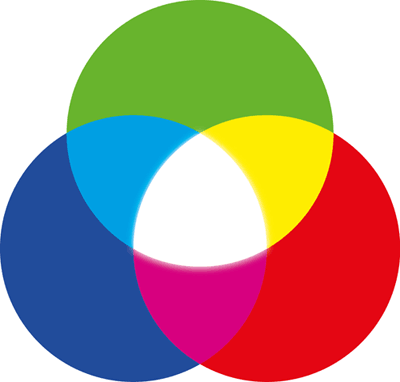
The blank white paper is white when we can see it through sparse ink. Less intense thinner CMY ink trends brighter, toward white, as reflected light when printed. The CMY inks absorb light, subtracting the complement color of the light, so subtraction of the reflected complement mix gets darker, due to absorption of more colors). CMY is about the light reflected from color pigments on physical objects (Subtractive Color).ĬMY color: The complements of RGB primaries are Cyan, Magenta, and Yellow, which are the CMY primary colors of pigments, of paint, ink, dye, etc, called the Subtractive system, which are viewed by reflected light (seen reflected from the inks or pigments printed on paper or canvas for example).

The difference is that RGB is about a direct beam of light transmitted into our eyes (Additive Color) vs. However, printers print with CMYK ink, because what we see is reflected light that was not absorbed by the printed ink, which becomes a different inverse principle.

The format of RGB nomenclature is RGB(255,255,255) is White (255 is the Maximum of 8-bit RGB), and RGB(0,0,0) is Black, which specifies the value of the combined Red, Green, and Blue components of the color. So White is balanced and bright enough to lighten Gray to White. Less intense RGB colors trend darker, toward black (if no light, no color). Neutral gray and even black is also a balanced color, meaning equal RGB components (no pinkish or bluish tints in the gray). White does not mean no color, it means equal RGB colors, balanced (all equal), so no color tints appear. Sunlight is white, a mix of all colors adding to white (around 5500°K) Sunlight mixes to what we call White, basically meaning bright and with no color cast. This is called Additive Color (mixing all RGB colors gets brighter, the sum of more light is brighter). The RGB primaries mixed together will ADD (gets brighter) to possibly combine into White if bright enough. We look directly at the transmitted light itself. The light from our monitor screen's RGB elements is seen directly by our eye. RGB color: Red, Green, and Blue are the RGB primary colors of light. There is another system called CIELAB or Lab Color ( Wikipedia) that tries to define a specific color independent of how various devices might be able to reproduce it. Our home printers also use CMYK ink, but they are designed to expect to receive and convert RGB images (such as JPG files), since that's what we have to print.īoth RGB and CMYK are “device dependent” color, meaning any final result somewhat depends on how the specific device is able to show it, like depending on just how red can the chosen ink or phosphorus actually make it? Different devices might show it a little different. Painting (art or painted things, etc.) and printing (commercial prepress, etc.) and pigments and ink and dye and photo prints use the CMYK system that we see as reflected from the colored surface. Raw files are not yet exactly RGB yet, but raw files are also not viewable images yet, not until the RGB conversion that we can view.

We view light transmitted directly from the source.

This article is about RGB color, which is universally used in our digital cameras and scanners, almost all photo image files, computers, video monitors, cell phones, television and computer screens, stage lighting, and about anything else working with light (and our human eyes are a RGB system too). We see the light reflected from the surface after the pigment color has absorbed some colors of it.


 0 kommentar(er)
0 kommentar(er)
